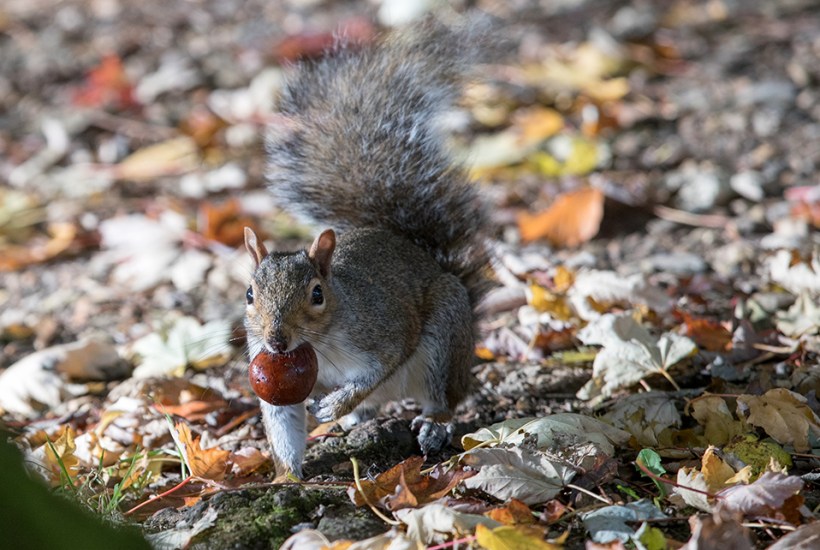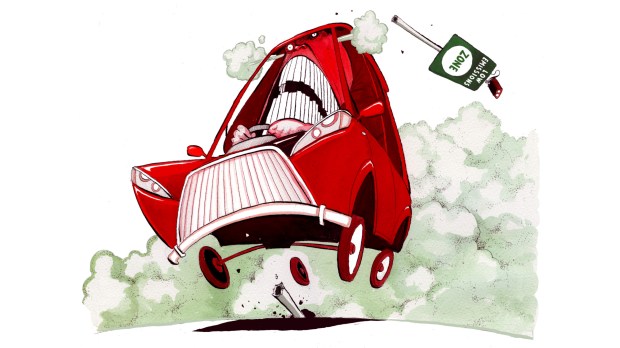Trying to work in my garden shed at this time of year is tricky. I will be crouched over my keyboard, face screwed up in concentration, when suddenly there’s a tremendous bang just above my head. Is it a bird? Is it a plane? No, it’s a conker falling from a horse-chestnut tree and hitting the roof of my office. It happens about once an hour, just infrequently enough to startle me every time.
I’ve grown to hate this tree over the years. It isn’t just the astonishingly loud noise the conkers make. It’s also the damage the tree does to the lawn. A typical conker will bounce off the shed and land on the grass, where it sits until a squirrel darts out of nowhere, picks up the mahogany orb with its two front paws, then uses its teeth to peel away some of the brown outer layer before digging a hole in the lawn and burying it. Why the squirrels do this is a bit of a mystery, given that the flesh is supposed to be poisonous and they rarely return to dig them up. It’s as though they’ve been enslaved by the tree and are labouring, zombie-like, to plant its seeds all over my lawn.
But the conkers aren’t the worst of it. In springtime, the tree starts shedding these reddish-brown buds which then get tangled in the dog’s fur. Their stickiness is quite incredible – Nature Journal even published a paper about it in 2020 (‘Robust, universal, and persistent bud secretion adhesion in horse-chestnut trees’). The only way to remove them from Mali’s coat is to cut them out, leaving her covered in bald patches. If the children run into the garden in their socks during the spring months, I scream at them to stop because if they tread on just one of these things the socks have to be thrown away.
Then there are the blasted leaves. Once autumn begins, the lawn becomes completely carpeted with the wretched things. I obsessively remove them throughout the day – or hoover them up with an expensive bit of gardening kit Caroline bought me. Then, when I wake up the following morning, a brand-new carpet has appeared. Sisyphus had nothing on me.
Last winter, I became so frustrated by the innumerable hours I spend battling with the horse-chestnut that I asked a tree surgeon to tell me how much it would cost to chop it down. I know, I know. That’s virtually sacrilegious in this nature-worshipping era, but in my defence the tree is home to a nasty little moth called Cameraria ohridella, which causes the leaves to turn brown from July onwards.
There is no way to treat this disease – it’s the herpes of horse-chestnuts. I told the tree surgeon I was concerned that this parasite would weaken the tree and it would fall over one day and crush my shed, along with all its contents. Which isn’t completely fanciful. The most famous horse-chestnut in the world – the Anne Frank tree in Amsterdam – blew over in a strong wind in 2010.
The estimate was £3,000 – cheap at the price, and it would clear a space beside my shed where I could put in an outside lavatory. But I had to get permission from Ealing council to take the tree down, and of course it was refused. Cue much gnashing of teeth.
I’ve been composing a stiff letter in my head ever since in which I tell the council that I’m perfectly happy to leave this natural wonder in place provided the council promises to indemnify me for any damage it does when it keels over. It’s so tall that if it falls due south it would cover the distance to the house and take out the conservatory. Trouble is, the council might well agree to that proposal. Horse–chestnuts can live forever with this pest, apparently, which causes no lasting damage.
It looks like I’ll just have to put up with this unfriendly giant, which means learning not to hate it. There are some positives. For the few weeks every year when it’s in full bloom and the leaves haven’t started to turn brown it looks pretty majestic. Certainly a lot prettier than the Acton skyline, which, in the words of a supercilious visitor from Notting Hill, has begun to resemble downtown Jersey City. It also shields the family from prying eyes in any of the new residential tower blocks.
Finally, there are the magical properties of the conkers when it comes to keeping spiders out of the house, something Caroline is a great believer in. Sometimes, when a conker hits my roof, I scuttle out and retrieve it and then carry it up to the house and present it to Caroline, like a member of the horse-chestnut’s squirrel army. It will eventually make slaves of us all.
Got something to add? Join the discussion and comment below.
Get 10 issues for just $10
Subscribe to The Spectator Australia today for the next 10 magazine issues, plus full online access, for just $10.
You might disagree with half of it, but you’ll enjoy reading all of it. Try your first month for free, then just $2 a week for the remainder of your first year.















Comments
Don't miss out
Join the conversation with other Spectator Australia readers. Subscribe to leave a comment.
SUBSCRIBEAlready a subscriber? Log in